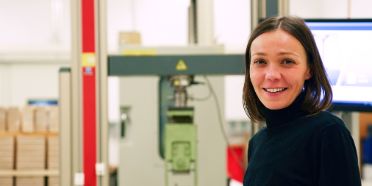- Story
Recycling more components
18.03.2024 Few existing components are reused in new construction projects in Switzerland. Bern University of Applied Sciences (BFH) carried out a study to explore why that is and what steps are needed to ensure more old components are used in new-build projects in future.
Why did BFH carry out a study on the recycling of construction components?
While the recycling of raw materials is well established in our society, the reuse of components has been kicked into the long grass – including in the construction industry. That’s why Nadine Gurtner and Barbora Starovicova, two researchers at BFH, decided to carry out the study. There’s enormous potential in recycling building materials – in fact the construction industry accounts for around a quarter of CO2 emissions in Switzerland.
As part of the study, the two researchers conducted just under 30 interviews with construction industry players about their experiences of recycling components. They included architects, planners, developers, manufacturers, building materials exchanges and demolition companies.
What were the results of the study?
The reuse of building components holds tremendous promise, but the recycling process in Switzerland is inadequate. An actual market is practically non-existent. That is not primarily because the stakeholders lack the will, but is instead due to a number of quite complex challenges which individual actors cannot resolve alone.
It’s often easier, quicker and cheaper to produce new components than to look for and use old ones.
So what are these challenges exactly?
First of all, there’s a lack of incentive for developers and construction firms to use recycled components. It’s often easier, quicker and cheaper to produce new components than to look for and use old ones. There’s a lack of information about when and where recycled materials are available. To provide recycled components on a large scale, the products must be attractive, have a high profile and be easily accessible for the industry.
There are also legal issues to consider. For example, it is unclear whether and how safety-related components, such as those used in fire protection products, can be reused and whether guarantee claims could be made. Finally, there are some conflicting objectives with other sustainable development goals. Windows provide a good example of this. Old windows reused in new buildings are generally less well insulated and energy efficient than new ones.
The ideal scenario would be the creation of a digitised information platform providing a clear overview of construction materials that would then be used in most existing and new buildings.
What measures are needed to improve recycling of construction materials?
A properly functioning marketplace is essential to increase reuse of components. The profile of the materials available must be raised too. The ideal scenario would be the creation of a digitised information platform providing a clear overview of construction materials that would then be used in most existing and new buildings. That would include information on age, origin, processing, dimensions and condition.
This kind of inventory would boost demand. Initially, it is important to focus on components that could achieve a big impact, such as materials used in large-scale development projects. It’s vital that all stakeholders shoulder their responsibility and don’t look to others to take the initiative.
What benefits does the study offer society?
The study clearly shows there are major levers available in the construction industry to support the sustainable development of society. If more recycled components were used in new projects, this would cut energy consumption in the manufacturing process, thereby reducing the carbon footprint. The study also shows all stakeholders how they can support the circular economy and help combat climate change.
BFH experts behind the study
Nadine Gurtner carried out the study on the recycling of construction components in cooperation with Barbora Starovicova.
Nadine Gurtner is an economist at the Institute for Innovation & Strategic Entrepreneurship at BFH’s Business School. In her research work she explores how innovation and entrepreneurship can create added value for society. Her research activities focus on decision-making and business models in the context of affordable innovation, social entrepreneurship and the circular economy.
Barbora Starovicova is a wood researcher at the Institute for Building Materials and Biobased Products at BFH’s Architecture, Wood and Civil Engineering Department.
This article first appeared in the Anzeiger Region Bern. It is part of a series in which research projects at Bern's universities are presented.


